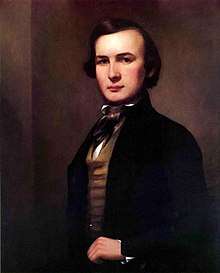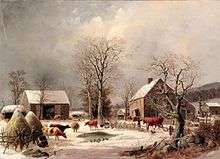George Henry Durrie
George Henry Durrie (June 6, 1820 – October 15, 1863) was an American artist whose rural winter scenes became popular when reproduced as lithographic prints by Currier and Ives.

He was born in Hartford, Connecticut. In his teens the self-taught artist painted portraits in the New Haven area. In 1839 he received artistic instruction from Nathaniel Jocelyn, a local engraver and portrait painter.[1] After 1842 he settled in New Haven, but made painting trips to New Jersey, New York, and Virginia.[1] Around 1850, he began painting genre scenes of rural life, as well as the winter landscapes that became popular when Currier and Ives published them as lithographs. Four prints were published between 1860 and the artist's death in New Haven in 1863; six additional prints were issued posthumously.[1] The painter Jeanette Shepperd Harrison Loop studied with him.[2]
Collections holding paintings by Durrie include the Smithsonian American Art Museum, Washington, D.C.; the Fine Arts Museums of San Francisco, the Museum of Fine Arts, Boston, the Shelburne Museum, Shelburne VT, the Virginia Museum of Fine Arts, and the White House.
Gallery
| Wikimedia Commons has media related to George Henry Durrie. |
- A Christmas Party
 1858 - Farmyard in Winter
1858 - Farmyard in Winter- 1858 - Red School House
- 1853 - Jones Inn
- 1853 - Going to Church
 Hunter in Winter Wood
Hunter in Winter Wood Winter Scene in New Haven, Connecticut
Winter Scene in New Haven, Connecticut
Notes
- National Museum of American Art & Kloss 1985, p. 191.
- David Bernard Dearinger; National Academy of Design (U.S.) (2004). Paintings and Sculpture in the Collection of the National Academy of Design: 1826–1925. Hudson Hills. pp. 20–. ISBN 978-1-55595-029-3.
References
- National Museum of American Art (U.S.), & Kloss, W. (1985). Treasures from the National Museum of American Art. Washington: National Museum of American Art. ISBN 0-87474-595-0